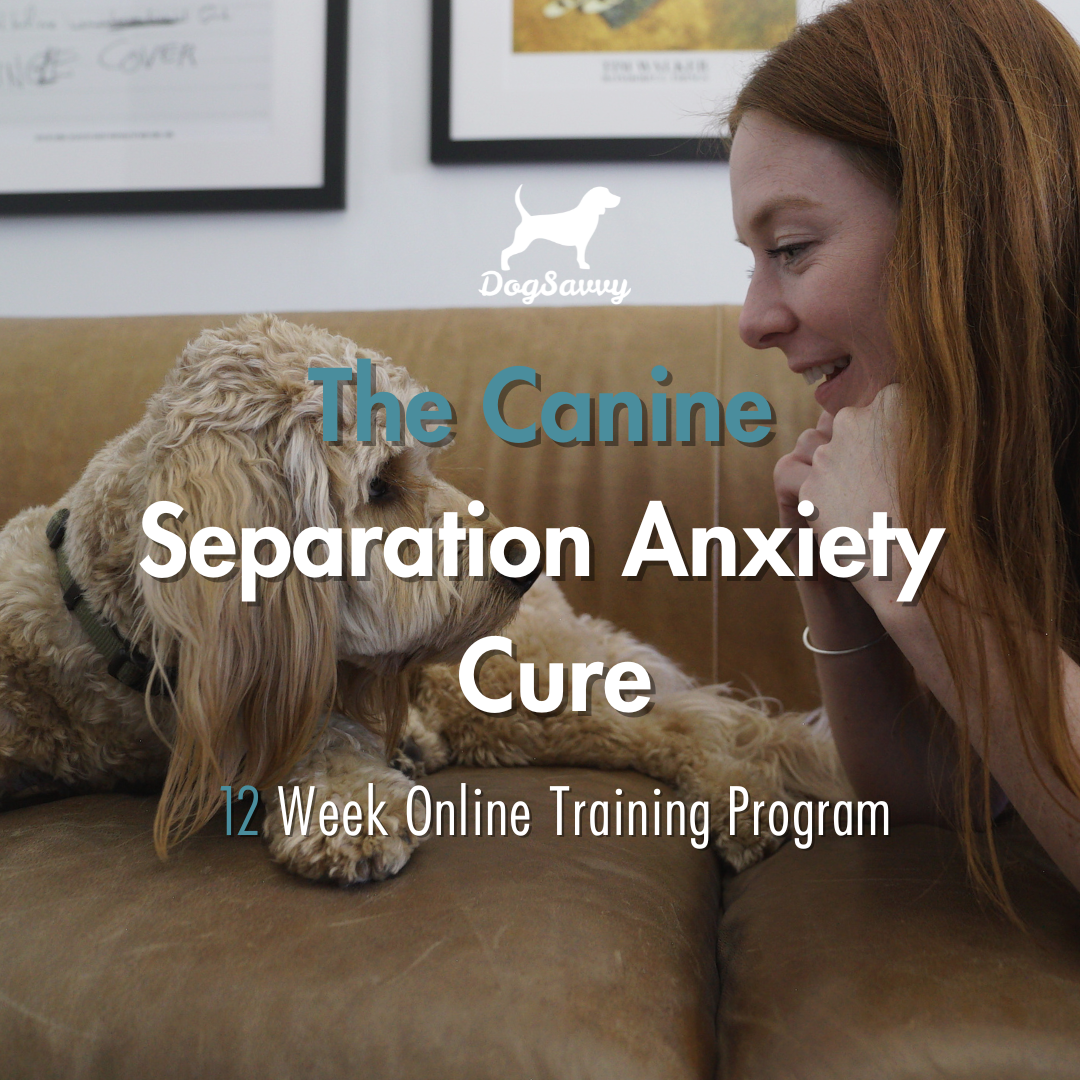How to Identify Dog Separation Anxiety — and How to Rule It Out
What Is Dog Separation Anxiety?
Dog separation anxiety is a condition that occurs when a dog becomes highly distressed, frustrated, or panicked when separated from a person or companion animal to whom they are attached. This behavior is most often triggered when a dog is:
Shut inside a crate, pen, or room
Blocked by barriers like doors, gates, or fences
Left at home alone (or in a car or yard alone)
Left behind in unfamiliar places (like at a daycare and boarding facility, or the groomer)
Separated from its guardian or preferred caregiver
These dogs are not simply misbehaving—they're having an emotional response rooted in fear and instinct. The intensity of their symptoms can vary from mild (not eating or drinking) to severe (escape attempts that result in injury or property damage).
Without proper intervention, separation anxiety rarely resolves on its own and tends to worsen over time, making everyday life with your dog increasingly stressful.
Common Symptoms of Dog Separation Anxiety
Not every dog with separation anxiety shows all of these signs, but here are the most common red flags:
Distress Vocalizations: Crying, whining, barking, or howling nonstop when left alone or confined. Neighbors may report noise.
Destruction: Chewing, digging, or scratching at doors, windows, crates, or walls—especially near exits—or the destruction of anything nearby like furniture or personal belongings.
House Soiling: Urinating or defecating indoors, even if your dog is housetrained.
Chronic Pacing: Repetitive pacing or circling when alone or confined.
Trembling and Drooling: Stress may cause persistent trembling and shaking or excessive drooling, to the point that a dog becomes soaked in its own drool.
Escape Attempts: Trying to break out of crates, pens, or rooms—sometimes injuring themselves in the process.
Following You Constantly: Velcro dogs that shadow you everywhere and can’t relax when you're out of sight, even momentarily, like when you take out the trash or take a bathroom break.
Over-the-Top Greetings: Frantic, excessive excitement when you return, even after a short absence.
Not Eating or Drinking: When dogs are under stress, their appetite is suppressed, which is why many won’t touch food or treat-dispensing toys in your absence.
Dogs with separation anxiety often hover near exit doors or stare intensely out windows, anxiously waiting for their person to return.
In most cases, symptoms begin immediately or within the first few minutes of being confined or left alone. Some dogs may have a delayed reaction if they’re unsure whether their guardian has truly left, but this is less common.
Once a dog’s stress response is activated, symptoms typically persist until they are reunited with their guardian or released from confinement.
What Causes Dog Separation Anxiety?
Pack instincts compel a dog to keep an eye on you and follow you everywhere.
The Role of Pack Instincts
Dogs are pack animals, biologically wired to stay close to their group. Pack instincts drive them to follow you from room to room and panic when they can't see or access you. This deep-rooted urge explains why dogs act as though they've been abandoned when left alone—even if they have an entire house to roam.
Because of this, we believe the condition known as "separation anxiety" is better understood as a pack instinct disorder caused by frustration and distress over not being able to fulfill their biological need to stay with their pack.
A Low Tolerance for Frustration
Another contributing factor is a low tolerance for frustration. Dogs who can’t self-soothe or regulate their emotions are more likely to vocalize excessively or act destructively when upset. These dogs benefit tremendously from structure and crate training or some form of confinement area training that gradually builds emotional resilience.
Abandonment Trauma
After experiencing sudden separation from their previous guardian (whether by mistake or design), we speculate that some rescue dogs have “abandonment trauma.”
As a result, they may obsessively follow their new guardians from room to room to keep an eye on them at all times. These dogs may also be adverse to being dropped off at a veterinary or grooming office, or a friend or family member’s place, if they don’t know them yet.
Common Situations that Trigger Separation Anxiety
Separation anxiety often stems from stressful or sudden changes in a dog’s life. Some of the most common triggers include:
Adoption into a New Home: The transition from a shelter, rescue, or previous home—especially after being separated from littermates or their mother for the first time—can be overwhelming.
Being Left Alone for the First Time: Dogs who are used to constant company may struggle when suddenly left alone.
Major Life Changes: Events like moving to a new home, divorce, the loss of a family member, or even a change in household dynamics can create anxiety.
Loss of a Companion: Whether it's a beloved human or animal friend, grief and confusion from a loss can trigger anxious behavior.
Change in Daily Routine: A shift in a dog’s daily schedule, such as returning to work after working remotely, can disrupt your dog’s sense of security.
Lack of Gradual Alone-Time or Crate Training: Puppies that haven’t been crate trained or taught how to be alone may grow up intolerant of solitude or being confined in a crate for any reason.
History of Rehoming, Abandonment, or Time in a Shelter: Dogs with unstable pasts may carry a deep fear of being abandoned again and may not want to take their eyes off you or be separated from you for any reason.
How to Rule Out Separation Anxiety
Sometimes, behaviors that look like separation anxiety are caused by other factors. It’s important to observe when symptoms occur.
If they occur whether you’re home or not, it may not be separation anxiety.
Other causes include:
Cabin Fever / Excess Energy: Dogs that don’t get enough physical or mental stimulation may resort to destructive behaviors out of boredom or pent-up energy. This can look like chewing furniture, barking excessively, or rummaging through the trash—not out of anxiety, but simply because they need an outlet.
Territorial Guarding: Dogs may patrol the house and bark at sounds or passersby all day because they are on “guard duty.”
Incomplete Housebreaking: Dogs may have accidents even when you’re home if they are not fully housebroken.
Fear: A sudden noise or environmental change can provoke escape attempts or destructive behavior.
Confinement Intolerance: Dogs who have not been crate-trained or spent time in a playpen may react to confinement by panicking.
Confinement Intolerance vs. Separation Anxiety
Dogs are naturally wired to roam, explore, and move freely through their environment. Because of this instinct, many dogs experience initial discomfort when placed in crates, playpens, or enclosed rooms—behavior known as confinement intolerance or crate anxiety.
With confinement intolerance, your dog may bark, whine, paw at the crate, or attempt to escape—not necessarily because they fear being alone, but because they feel trapped or restricted. This is a common and normal reaction, especially if crate training or confinement is new.
Understandably, many pet parents see these early signs of protest and decide to end crate or pen training, allowing their dog full access to the house before they're truly ready for that level of freedom.
However, if a dog never learns to tolerate short periods of confinement or alone time, nuisance behaviors like whining, crying, barking, or destructive chewing can escalate. Over time, what began as crate anxiety or simple resistance can develop into true dog separation anxiety, where the dog panics at any sign of being left alone.
Successfully addressing confinement intolerance with gentle, gradual training helps prevent these issues and sets your dog up for calm, confident independence.
It’s important to note that confinement intolerance and separation anxiety often look similar, especially in newly adopted puppies or rescue dogs. However, there is one key difference:
A dog with separation anxiety becomes distressed whenever they are separated from their guardian, regardless of whether they’re confined or have the freedom to roam.
A confinement-intolerant dog may tolerate being alone but struggles with being confined.
How to Tell the Difference: Conduct a Couple of Tests
To determine which issue your dog is dealing with, try conducting two simple tests:
Confine your dog in a crate or pen while you remain at home.
Leave your dog alone with access to the entire house.
Compare the behavior in both situations. If your dog only struggles when confined, it’s likely a case of confinement intolerance. If they show distress in both scenarios, separation anxiety may be the root issue.
Expect an Adjustment Period After a Move or Adoption
If you’ve just brought a dog or new puppy home or recently moved, expect a 2- to 4-week adjustment period.
During this time, your dog is learning your routine and adapting to a new environment.
It’s normal to see mild signs of stress—like restlessness, pacing, or temporary changes in behavior—which often resolve naturally once your dog begins to feel safe and secure.
👉 For more proactive tips on how to ease this transition, see our guides:
Final Thoughts: Support Your Dog Through Separation Anxiety or Confinement Struggles
It’s normal for puppies and newly adopted dogs to feel uneasy the first few times they’re crated or left alone.
But if that stress continues beyond the initial adjustment period, it could be a sign of separation anxiety or confinement intolerance—two distinct issues that require different training strategies.
Understanding what your dog is truly experiencing is the first step toward helping them feel safe and confident on their own. Remember, your dog isn’t being stubborn or dramatic—they’re expressing emotional distress the only way they know how.
With the right support, training plan, and plenty of patience, your dog can learn to self-soothe and thrive when home alone.
Next Steps: Get Help Now from a Dog Separation Anxiety Specialist
At Dog Savvy, we specialize in gentle, science-based separation anxiety training for dogs.
Our positive reinforcement methods are proven to reduce anxiety, eliminate problem behaviors, and help your dog feel calm and confident when left alone.
With expert guidance from our separation anxiety specialist, most dogs see lasting results in just 8 to 12 weeks.
👉 Book a personalized Intro Session today and take the first step toward a happier, more independent dog—and a stress-free home life.





Can’t leave your dog alone? Don’t lose hope—there is a solution.
If your dog struggles with separation anxiety, our virtual training program provides a gentle, effective approach that helps dogs become calm, confident, and comfortable when left alone—often in just 8 to 12 weeks.
Take the first step toward peace of mind and a happier, more relaxed dog.
👉 Book your Intro Session now!